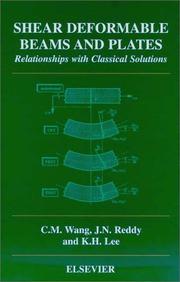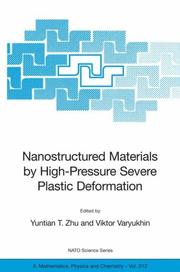| Listing 1 - 4 of 4 |
Sort by
|

ISBN: 1281072206 9786611072209 0080541151 9780080541150 9780080437842 0080437842 9781281072207 0080437842 Year: 2000 Publisher: Amsterdam ; New York : Elsevier,
Abstract | Keywords | Export | Availability | Bookmark
 Loading...
Loading...Choose an application
- Reference Manager
- EndNote
- RefWorks (Direct export to RefWorks)
Most books on the theory and analysis of beams and plates deal with the classical (Euler-Bernoulli/Kirchoff) theories but few include shear deformation theories in detail. The classical beam/plate theory is not adequate in providing accurate bending, buckling, and vibration results when the thickness-to-length ratio of the beam/plate is relatively large. This is because the effect of transverse shear strains, neglected in the classical theory, becomes significant in deep beams and thick plates. This book illustrates how shear deformation theories provide accurate solutions compared to the clas
Deformations (Mechanics). --- Girders. --- Mathematical analysis. --- Plates (Engineering). --- Plates (Engineering)--Mathematical models. Girders--Mathematical models. Shear (Mechanics) Deformations (Mechanics) Mathematical analysis. --- Shear (Mechanics). --- Plates (Engineering) --- Girders --- Shear (Mechanics) --- Deformations (Mechanics) --- Mathematical models. --- 517.1 Mathematical analysis --- Mathematical analysis --- Shear lag --- Beams --- Disks (Mechanics) --- Panels --- Structural plates --- Elastic solids --- Mechanics --- Rheology --- Strains and stresses --- Structural failures --- Elasticity --- Bars (Engineering) --- Structural frames --- Graphic statics --- Elastic plates and shells --- Structural analysis (Engineering) --- Shells (Engineering) --- Cisaillement (Mécanique) --- Déformations (Mécanique) --- Analyse mathématique --- Mathematical models --- ELSEVIER-B EPUB-LIV-FT --- Plates --- Shears

ISBN: 1402039220 1402039212 1402039239 9786611336042 1281336041 Year: 2006 Volume: 212 Publisher: Dordrecht : Springer Netherlands : Imprint: Springer,
Abstract | Keywords | Export | Availability | Bookmark
 Loading...
Loading...Choose an application
- Reference Manager
- EndNote
- RefWorks (Direct export to RefWorks)
Recently, it was reported that nanostructured materials processed under high pressure by HPT and ECAP have an extraordinary combination of both high strength and high ductility, which are two desirable, but rarely co-existing properties. These findings indicate that high-pressure is a critical factor that can be employed to process nanostructured materials with superior mechanical, and possibly also physical, properties. It is the objective of this workshop to review our current knowledge, identify issues for future research, and discuss future directions on the processing and properties of nanostructured materials via SPD techniques, with a special emphasis on high-pressure effects. The 42 peer-reviewed papers in this book cover areas of high pressure effect on the nanostructure and properties of SPD-processed materials, fundamentals of nanostructured materials, development of high-pressure SPD technologies for commercializations, recent advances of SPD technologies as well as applications and future markets of SPD-processed nanostructured materials.
Nanostructured materials. --- Plastics --- Deformations (Mechanics). --- Nanomatériaux --- Matières plastiques --- Déformations (Mécanique) --- Nanostructured materials - Congresses. --- Nanostructured materials --- Plastics at high pressures --- Deformations (Mechanics) --- Nanotechnology --- Materials Science --- Chemical & Materials Engineering --- Engineering & Applied Sciences --- Plastic deformation --- Nanomatériaux --- Matières plastiques --- Déformations (Mécanique) --- EPUB-LIV-FT LIVCHIMI SPRINGER-B --- Materials science. --- Continuum mechanics. --- Nanotechnology. --- Metals. --- Materials Science. --- Materials Science, general. --- Metallic Materials. --- Continuum Mechanics and Mechanics of Materials. --- High pressure (Technology) --- Materials at high pressures --- Congresses --- Materials. --- Mechanics. --- Mechanics, Applied. --- Solid Mechanics. --- Applied mechanics --- Engineering, Mechanical --- Engineering mathematics --- Classical mechanics --- Newtonian mechanics --- Physics --- Dynamics --- Quantum theory --- Molecular technology --- Nanoscale technology --- High technology --- Engineering --- Engineering materials --- Industrial materials --- Engineering design --- Manufacturing processes --- Materials --- Metallic elements --- Chemical elements --- Ores --- Metallurgy --- Material science --- Physical sciences
Book
ISBN: 3642434002 364238546X 3642385478 9783642385469 Year: 2013 Publisher: Heidelberg [Germany] : Springer,
Abstract | Keywords | Export | Availability | Bookmark
 Loading...
Loading...Choose an application
- Reference Manager
- EndNote
- RefWorks (Direct export to RefWorks)
There have been many excellent books written on the subject of plastic deformation in solids, but rarely can one find a textbook on this subject. “Plasticity Modeling & Computation” is a textbook written specifically for students who want to learn the theoretical, mathematical, and computational aspects of inelastic deformation in solids. It adopts a simple narrative style that is not mathematically overbearing, and has been written to emulate a professor giving a lecture on this subject inside a classroom. Each section is written to provide a balance between the relevant equations and the explanations behind them. Where relevant, sections end with one or more exercises designed to reinforce the understanding of the “lecture.” Color figures enhance the presentation and make the book very pleasant to read. For professors planning to use this textbook for their classes, the contents are sufficient for Parts A and B that can be taught in sequence over a period of two semesters or quarters.
Continuum mechanics. --- Elastoplasticity. --- Numerical analysis. --- Plasticity. --- Mechanical Engineering --- Civil & Environmental Engineering --- Engineering & Applied Sciences --- Hydraulic Engineering --- Civil Engineering --- Deformations (Mechanics) --- Engineering. --- Earth sciences. --- Engineering geology. --- Engineering --- Foundations. --- Hydraulics. --- Geoengineering, Foundations, Hydraulics. --- Continuum Mechanics and Mechanics of Materials. --- Earth Sciences, general. --- Geology. --- Elastic solids --- Mechanics --- Rheology --- Strains and stresses --- Structural failures --- Cohesion --- Elasticity --- Plastics --- Hydraulic engineering. --- Mechanics. --- Mechanics, Applied. --- Geography. --- Solid Mechanics. --- Cosmography --- Earth sciences --- World history --- Applied mechanics --- Engineering, Mechanical --- Engineering mathematics --- Classical mechanics --- Newtonian mechanics --- Physics --- Dynamics --- Quantum theory --- Engineering, Hydraulic --- Fluid mechanics --- Hydraulics --- Shore protection --- Engineering—Geology. --- Geosciences --- Environmental sciences --- Physical sciences --- Flow of water --- Water --- Hydraulic engineering --- Jets --- Architecture --- Building --- Structural engineering --- Underground construction --- Caissons --- Earthwork --- Masonry --- Soil consolidation --- Soil mechanics --- Walls --- Civil engineering --- Geology, Economic --- Flow --- Distribution --- Details --- Geology --- Plasticity --- Plasticité --- Déformations (mécanique) --- Mathematical models. --- Modèles mathématiques. --- Plasticité --- Déformations (mécanique) --- Modèles mathématiques.
Book
ISBN: 9780691133027 0691133026 1282608215 9786612608216 140083385X 9781400833856 9781282608214 Year: 2010 Publisher: Princeton, N.J. Princeton University Press
Abstract | Keywords | Export | Availability | Bookmark
 Loading...
Loading...Choose an application
- Reference Manager
- EndNote
- RefWorks (Direct export to RefWorks)
Earthquake and Volcano Deformation is the first textbook to present the mechanical models of earthquake and volcanic processes, emphasizing earth-surface deformations that can be compared with observations from Global Positioning System (GPS) receivers, Interferometric Radar (InSAR), and borehole strain- and tiltmeters. Paul Segall provides the physical and mathematical fundamentals for the models used to interpret deformation measurements near active faults and volcanic centers.Segall highlights analytical methods of continuum mechanics applied to problems of active crustal deformation. Topics include elastic dislocation theory in homogeneous and layered half-spaces, crack models of faults and planar intrusions, elastic fields due to pressurized spherical and ellipsoidal magma chambers, time-dependent deformation resulting from faulting in an elastic layer overlying a viscoelastic half-space and related earthquake cycle models, poroelastic effects due to faulting and magma chamber inflation in a fluid-saturated crust, and the effects of gravity on deformation. He also explains changes in the gravitational field due to faulting and magmatic intrusion, effects of irregular surface topography and earth curvature, and modern concepts in rate- and state-dependent fault friction. This textbook presents sample calculations and compares model predictions against field data from seismic and volcanic settings from around the world.Earthquake and Volcano Deformation requires working knowledge of stress and strain, and advanced calculus. It is appropriate for advanced undergraduates and graduate students in geophysics, geology, and engineering. Professors: A supplementary Instructor's Manual is available for this book. It is restricted to teachers using the text in courses. For information on how to obtain a copy, refer to: http://press.princeton.edu/class_use/solutions.html
Rock deformation --- Strains and stresses --- Volcanism. --- Earthquakes. --- Deformations (Mechanics) --- Mathematical models. --- Volcanism --- Earthquakes --- Volcanisme --- Tremblements de terre --- Déformations (Mécanique) --- Mathematical models --- Deformations (Mechanics). --- Rock deformation - Mathematical models. --- Rock deformation -- Mathematical models. --- Strains and stresses - Mathematical models. --- Strains and stresses -- Mathematical models. --- Volcanicity --- Vulcanism --- Stresses and strains --- Elastic solids --- Mechanics --- Rheology --- Structural failures --- Quakes (Earthquakes) --- Earth movements --- Natural disasters --- Seismology --- Geodynamics --- Volcanology --- Architectural engineering --- Engineering, Architectural --- Architecture --- Flexure --- Statics --- Structural analysis (Engineering) --- Elasticity --- Engineering design --- Graphic statics --- Strength of materials --- Stress waves --- Structural design --- Deformation, Rock --- Geology, Structural --- Rock deformation - Mathematical models --- Strains and stresses - Mathematical models --- 1906 San Francisco earthquake. --- 1980 eruption of Mount St. Helens. --- 1989 Loma Prieta earthquake. --- 1992 Landers earthquake. --- 1999 Hector Mine earthquake. --- Active fault. --- Atmospheric refraction. --- Cauchy stress tensor. --- Compressive stress. --- Continental collision. --- Continuum mechanics. --- Crust (geology). --- Deformation (engineering). --- Deformation (mechanics). --- Deformation monitoring. --- Dike (geology). --- Dislocation. --- Displacement field (mechanics). --- Earthquake prediction. --- Earthquake rupture. --- Earthquake swarm. --- Elasticity (physics). --- Explosive eruption. --- Fault (geology). --- Fault friction. --- Figure of the Earth. --- Fracture mechanics. --- Fracture toughness. --- Fracture zone. --- Fracture. --- Friction. --- Geodetic datum. --- Geologic time scale. --- Geothermal gradient. --- Gravitational acceleration. --- Gravitational potential. --- Gravity Recovery and Climate Experiment. --- Hawaiian Volcano Observatory. --- Infinitesimal strain theory. --- Intraplate earthquake. --- Lava dome. --- Lava lake. --- Lava. --- Long Valley Caldera. --- Magma chamber. --- Magnetic anomaly. --- Melting point. --- Mount St. Helens. --- Nucleation. --- Orogeny. --- Oscillation. --- Parkfield earthquake. --- Plane stress. --- Plate tectonics. --- Porosity. --- Pressure gradient. --- Radiation stress. --- Resurgent dome. --- Rift zone. --- Rock (geology). --- Rock mechanics. --- San Andreas Fault. --- Seafloor spreading. --- Seismic gap. --- Seismic hazard. --- Seismic moment. --- Seismic risk. --- Seismic tomography. --- Seismic wave. --- Seismology. --- Shear modulus. --- Shear stress. --- Shear zone. --- Shearing (physics). --- Shield volcano. --- Strain energy. --- Strain rate. --- Stratovolcano. --- Stress concentration. --- Stress functions. --- Stress intensity factor. --- Subduction. --- Subsidence. --- Surface energy. --- Surface gravity. --- Surface stress. --- Tectonophysics. --- Tension (physics). --- Thermal expansion. --- Thrust fault. --- Traction (engineering). --- Transform fault. --- Types of volcanic eruptions. --- Vibration. --- Viscoelasticity. --- Volcanic hazards. --- Volcanic pipe. --- Volcano. --- Wavenumber. --- Yield (engineering).
| Listing 1 - 4 of 4 |
Sort by
|

 Search
Search Feedback
Feedback About
About Help
Help News
News